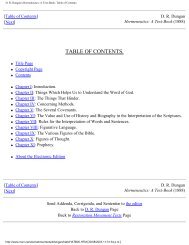Dungan - Hermeneutics
The Art and Science out interfering scripture.
The Art and Science out interfering scripture.
You also want an ePaper? Increase the reach of your titles
YUMPU automatically turns print PDFs into web optimized ePapers that Google loves.
D. R. <strong>Dungan</strong>'s <strong>Hermeneutics</strong>: A Text-Book: Table of Contents.<br />
SEC. 46. WHEN WRITTEN? 167<br />
SEC. 47. THE PLACE OF WRITING OR SPEAKING? 169<br />
CHAPTER VII.<br />
RULES FOR THE INTERPRETATION OF WORDS AND SENTENCES.<br />
SEC. 48. HOW TO INTERPRET SENTENCES. Rule 1. Always interpret according to the<br />
known purpose of the author. This is observed in history and law. Exception of<br />
incidental remark only apparent. 172<br />
SEC. 49. BUT HOW KNOW THE PURPOSE OF THE AUTHOR? Rule 1. The writer's statement,<br />
or some one else authoritatively stating it. Rule 2. Carefully consider the immediate<br />
context. What is truth? Lovest thou me more than these? Rule 3. The Bible must<br />
harmonize. Objection answered. Rule 4. Compare with other statements of the<br />
author. Rule 5. Compare with statements of others who speak with equal authority.<br />
Rule 6. The use of common sense respecting the things we know, of ourselves.<br />
Caution in the use of this rule. Rule 7. Interpret figurative language by the laws<br />
governing the figures employed. 176<br />
SEC. 50. RULES BY WHICH THE MEANING OF WORDS SHALL BE ASCERTAINED. Rule 1. All<br />
words are to be understood in their literal sense, unless the evident meaning of the<br />
context forbids. Rule 2. Commands generally, and ordinances always, are to be<br />
understood in a literal sense. Rule 3. The literal meaning of a word is that meaning<br />
given it by those to whom it is addressed. But how know that meaning. Rule 4. The<br />
Scriptures are supposed to give to some words meaning which they do not have in<br />
the classics, and therefore the Bible becomes a dictionary of itself. This only partly<br />
true. Rule 5. Words of definite action can have but one meaning. The action,<br />
however, may have different results. Rule 6. The writer's explanation is the best<br />
definition that can be found. Rule 7. The proper definition of a word may be used in<br />
the place of the word. Rule 8. By antithesis. Rule 9. By the general and special<br />
scope. See the plan of the Roman letter. Rule 10. Etymological construction will<br />
many times tell the meaning of the word. Rule 11. The meaning of a word may be<br />
known by other words used in construction with it. Rule 12. The history of a word<br />
has sometimes to be studied. Terry, on the change in the meanings of words. Rule<br />
13. Illustrations or parables give the peculiar meaning sometimes. Who is my<br />
neighbor? Rule 14. In defining a definition, nothing but primary meanings can he<br />
used. 184<br />
CHAPTER VIII.<br />
FIGURATIVE LANGUAGE.<br />
http://www.mun.ca/rels/restmov/texts/ddungan/hatb/HATB00C.HTM (6 of 10) [30/08/2003 11:31:43 p.m.]




